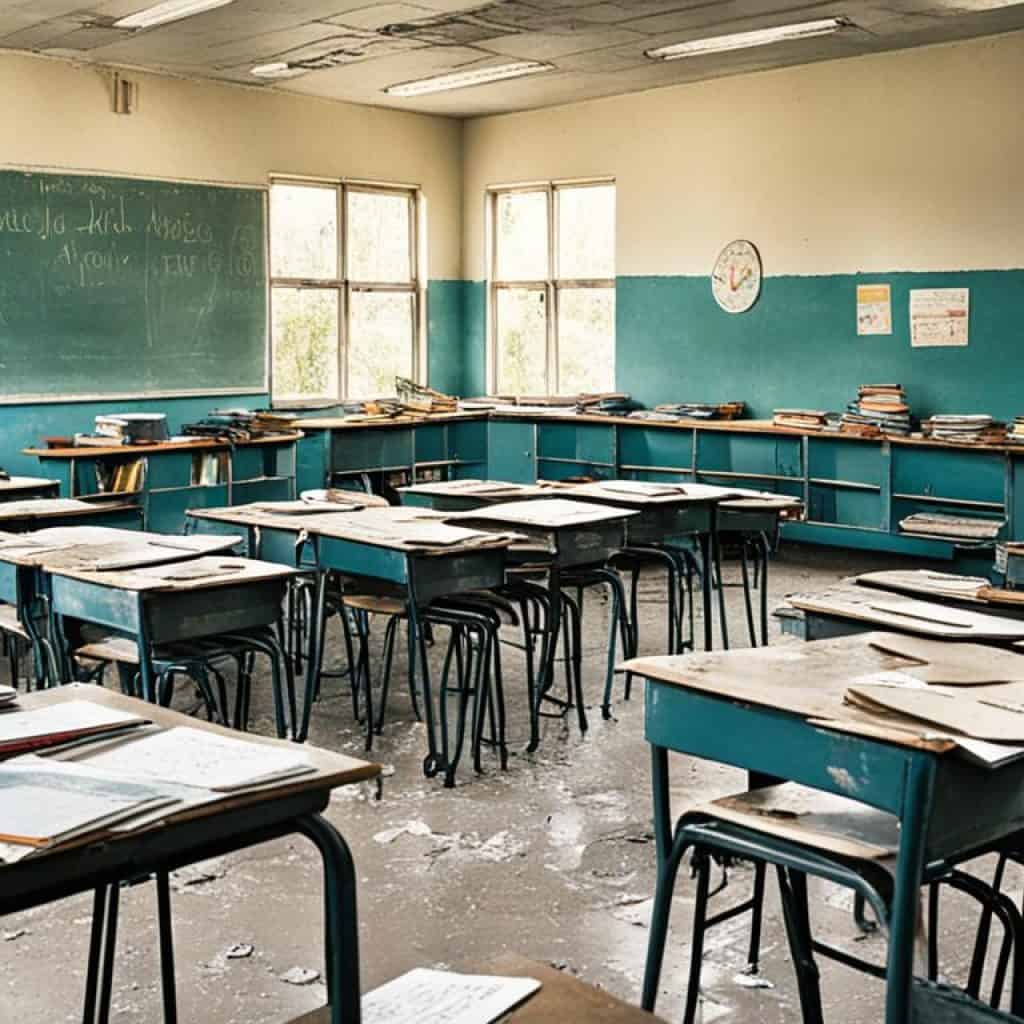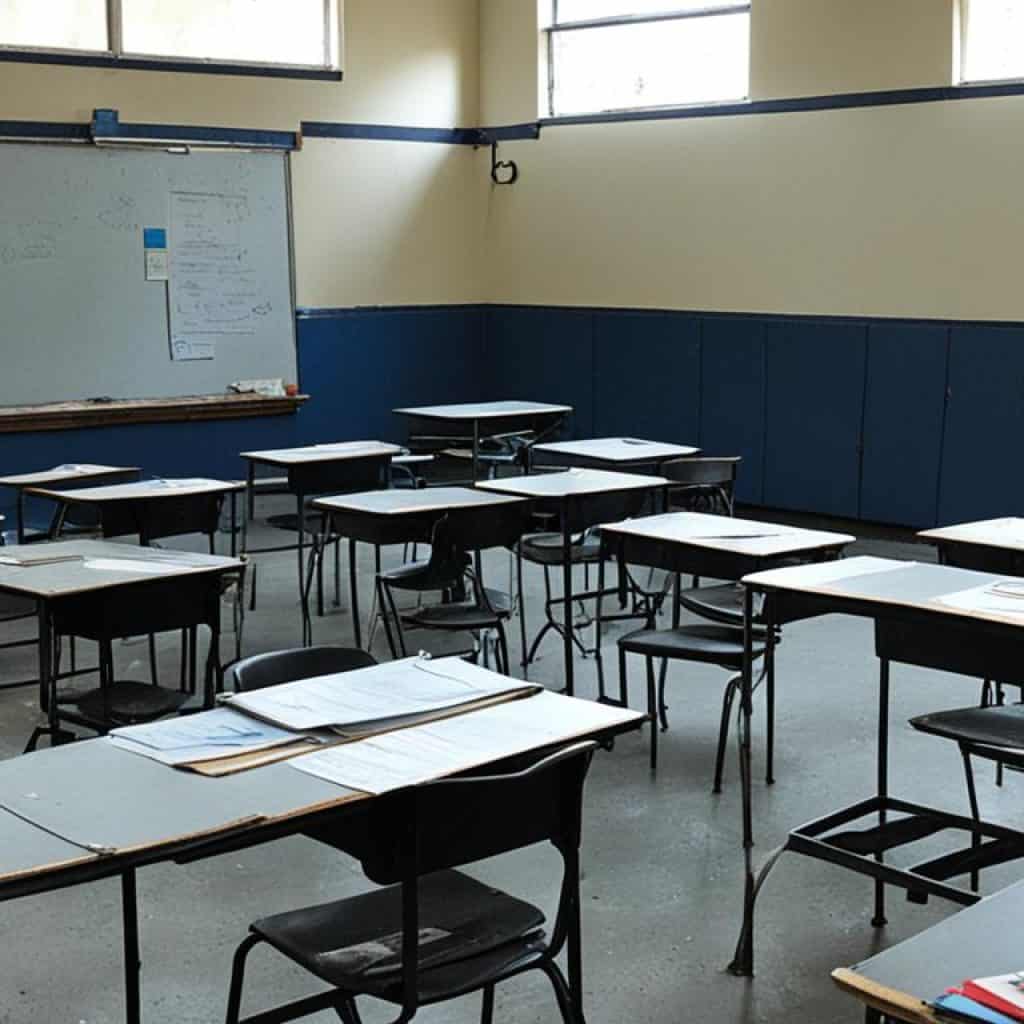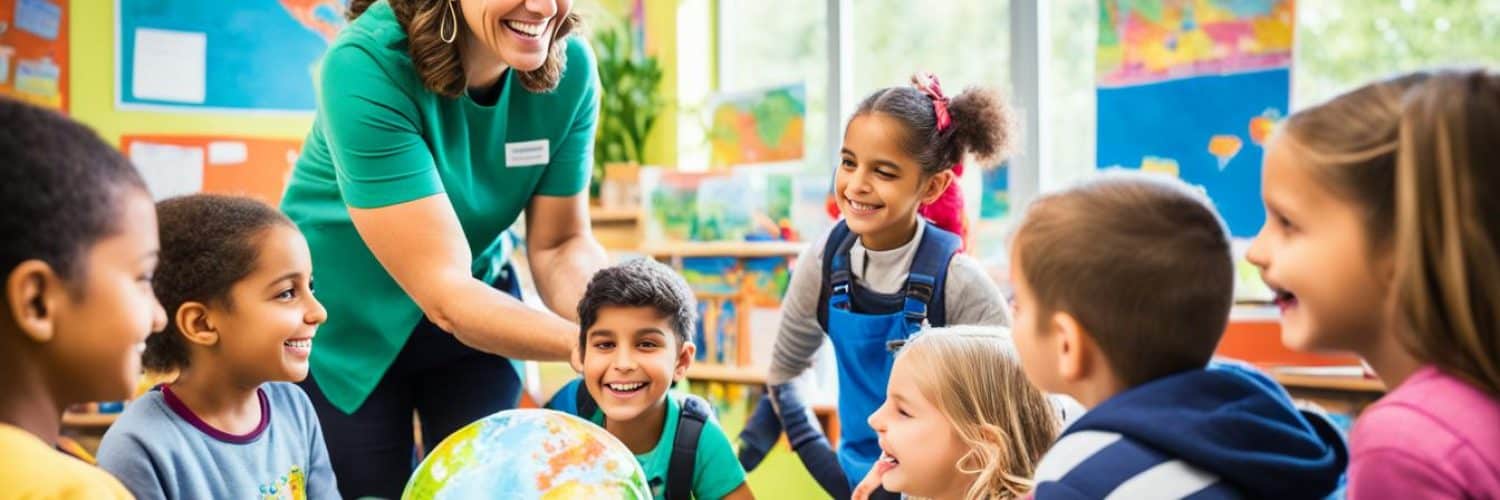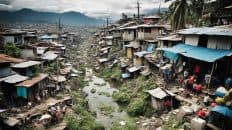Are you wondering how the Philippines can ensure quality education for all its students? Despite the challenges faced by the education system, there are efforts underway to improve the quality of education throughout the country. From top universities in the Philippines to international schools in Manila, discover how the Philippines is striving for academic excellence.
Key Takeaways:
- The Philippines has been working to address challenges in its education system, including inadequate funding and lack of trained teachers.
- Historical influences from colonization have shaped the education system in the Philippines.
- Inefficiencies like an outdated curriculum and insufficient infrastructure contribute to the struggle for quality education in the Philippines.
- Poverty and armed conflict also pose obstacles to education in the country.
- Efforts are being made by the government and various organizations to improve education and provide more opportunities for students.
History of Education in the Philippines
The education system in the Philippines has been significantly influenced by its history of colonization. Understanding the historical context helps shed light on the current state of education in the country.
During the Spanish colonial period, from the 16th to the late 19th century, education in the Philippines centered on indoctrination and social control. The primary goal of education at that time was to instill religious beliefs and promote obedience to the Spanish authorities. Critical thinking was not emphasized, and education was primarily reserved for the elite.
The American period, which followed the Spanish era, brought about significant changes in the Philippine education system. Under American rule from 1898 to 1946, the United States introduced a public school system to prepare Filipinos for employment and assimilation into American society.
“Education is the key to success in the struggle for existence.” – William Taft
The American influence brought a more structured approach to education, with standardized curriculum and teacher training programs. English became the medium of instruction, and the focus shifted towards practical skills necessary for the workforce. This period played a crucial role in shaping the educational landscape in the Philippines, emphasizing the importance of education as a means to achieve personal success.
Today, the history of education in the Philippines continues to leave lasting impressions on the system. While efforts have been made to adapt to the changing needs of the society and address the challenges faced, remnants of the past can still be seen in certain aspects of education.
Comparison of Spanish and American Periods in Philippine Education
| Aspect | Spanish Period | American Period |
|---|---|---|
| Focus of Education | Indoctrination and social control | Preparation for employment and assimilation |
| Language of Instruction | Spanish | English |
| Access to Education | Limited to the elite | More accessible, public school system |
| Curriculum | Religious teachings, classical subjects | Standardized curriculum, practical skills |
The history of education in the Philippines serves as a foundation for understanding the challenges and opportunities present in the current education system. Recognizing the historical context helps shape future efforts to provide quality education to all Filipinos.
Challenges in the Education System
The education system in the Philippines faces several challenges that hinder the delivery of quality education and limit opportunities for students. These challenges include inadequate funding, a lack of trained and qualified teachers, an outdated curriculum, and insufficient infrastructure.
Inadequate Funding
Inadequate funding is a significant obstacle in the Philippine education system. The education sector receives a low allocation of the national budget compared to other sectors, which impacts the availability of resources necessary for quality education, such as teaching tools, textbooks, and technology infrastructure.
Lack of Trained and Qualified Teachers
The shortage of trained and qualified teachers is another major challenge. Many teachers in the Philippines lack proper training and educational qualifications, compromising the transfer of knowledge and skills to students. This shortage hampers effective teaching and limits students’ academic potential.
Outdated Curriculum
The current curriculum in the Philippines has been criticized for its emphasis on rote memorization and the accumulation of facts, rather than developing critical thinking, problem-solving, and creativity. This outdated approach fails to equip students with the necessary skills to thrive in a dynamic and globalized world.
Insufficient Infrastructure
Many schools in the Philippines suffer from a lack of basic facilities, including classrooms, libraries, laboratories, and sanitation facilities. This insufficient infrastructure hinders the teaching and learning process, impeding students’ ability to reach their full potential. Additionally, transportation issues in rural areas further affect access to education.
Addressing the Challenges
The Philippine government has recognized these challenges and is taking steps to address them. Efforts are being made to increase funding for education, improve teacher training programs, update the curriculum to be more relevant and skills-focused, and invest in the necessary infrastructure to support quality education for all.
However, overcoming these challenges requires concerted efforts from various stakeholders, including the government, educators, parents, and the community. By working together, the education system in the Philippines can overcome these obstacles and provide a better future for the students.
Inadequate Funding in the Education System
Inadequate funding is a significant challenge in the Philippine education system. The education sector receives a low allocation of the national budget compared to other sectors. This lack of funding affects the availability of resources, such as teaching tools, textbooks, and technology infrastructure, which are essential for quality education.

Insufficient funding hampers the ability of schools and universities in the Philippines to provide quality education to students. Without adequate financial resources, educational institutions struggle to update their facilities and provide modern learning materials. This situation not only hinders students’ ability to gain knowledge and develop necessary skills but also limits their opportunities for academic achievement.
This issue is further compounded by the unequal distribution of funds across regions in the Philippines. Disadvantaged areas with limited resources suffer the most, leaving students in these areas at a disadvantage when it comes to receiving a quality education.
The Impact of Inadequate Funding
The consequences of inadequate funding in the education system are far-reaching. Here are some key areas where the impact is most evident:
- Insufficient resources: Inadequate funding leads to a lack of teaching tools, textbooks, and technology infrastructure. This deprives students of essential resources for effective learning and limits their exposure to modern educational practices.
- Overcrowded classrooms: Limited funding often results in overcrowded classrooms, making it difficult for teachers to provide individual attention to students. This affects the quality of instruction and impedes students’ ability to grasp concepts effectively.
- Inadequate teacher training: Limited funds make it challenging to invest in the professional development of teachers. Without proper training and up-to-date pedagogical practices, teachers may struggle to deliver quality education to their students.
- Inequality in education: Inadequate funding exacerbates educational disparities between urban and rural areas, as well as high-income and low-income communities. Students from disadvantaged backgrounds often lack access to resources and opportunities available to their more privileged counterparts.
Inadequate funding in the Philippine education system perpetuates inequality and limits students’ ability to reach their full potential. It is crucial for the government and relevant stakeholders to prioritize education and allocate sufficient funds for the development of a high-quality and inclusive education system.
| Impacts of Inadequate Funding | Statistics |
|---|---|
| Number of schools lacking basic facilities | 43% |
| Percentage of students without access to textbooks | 27% |
| Ratio of students per teacher in public schools | 1:45 |
| Percentage of national budget allocated to education | 16% |
The above table highlights the dire situation caused by inadequate funding in the Philippine education system. With a large percentage of schools lacking basic facilities and students lacking access to textbooks, urgent action is needed to address the funding gap and ensure equal educational opportunities for all.
Lack of Trained and Qualified Teachers
One of the major challenges in the Philippine education system is the lack of trained and qualified teachers, particularly in remote and disadvantaged areas. This shortage of educators has a significant impact on the transfer of knowledge and skills to students, hindering effective teaching and limiting their academic potential.
Qualified teachers are crucial for fostering a conducive learning environment and providing students with quality education. However, many teachers in the Philippines lack proper training and educational qualifications. This not only affects the overall quality of teaching but also hampers the development of critical thinking, problem-solving, and other key skills among students.
To overcome this issue, it is imperative to invest in comprehensive teacher training programs and ensure that educators have the necessary qualifications and expertise. By providing continuous professional development opportunities and support, teachers can enhance their teaching methodologies and stay updated with the latest educational practices and innovations.
Furthermore, efforts should be made to attract more individuals to the teaching profession and encourage them to pursue higher education degrees in relevant fields. Scholarships and incentives can be provided to aspiring educators, particularly those belonging to underprivileged communities, to increase their participation in the teaching workforce.
“Education is the most powerful weapon which you can use to change the world.” – Nelson Mandela
The Impact of the Lack of Qualified Teachers
The lack of trained and qualified teachers in the Philippine education system has several adverse consequences for both students and the wider society. Some of these key impacts include:
- Reduced learning outcomes and academic performance.
- Underutilization of potential talent and abilities among students.
- Higher dropout rates and limited access to higher education.
- Increased educational disparities, especially in remote and disadvantaged areas.
- Impacted socio-economic development and decreased competitiveness in the global market.
Addressing the shortage of qualified teachers is crucial for achieving quality education and unlocking the full potential of students in the Philippines.
Outdated Curriculum in the Philippines
The current curriculum in the Philippines has come under scrutiny for its outdated approach to education. The focus on rote memorization and the accumulation of facts limits students’ ability to develop critical thinking, problem-solving, and creativity skills. This traditional teaching method fails to equip students with the necessary skills to thrive in a dynamic and globalized world.
Instead of fostering innovation and independent thinking, the outdated curriculum encourages passive learning and memorization. Students are often taught to regurgitate information without fully understanding or applying it. This approach hampers their ability to analyze and solve real-world problems, hindering their overall intellectual growth.
“Education is not the learning of facts, but the training of the mind to think.” – Albert Einstein
It is essential for the education system to adapt to the changing needs of society and the demands of the modern workforce. An updated curriculum should emphasize critical thinking, creativity, and problem-solving, preparing students for the challenges and opportunities of the 21st century.
The Importance of an Updated Curriculum
- Promoting critical thinking: An updated curriculum would encourage students to analyze information, think critically, and evaluate different perspectives. This skill is crucial for making informed decisions and solving complex problems.
- Fostering creativity: By incorporating creative and innovative approaches, an updated curriculum would nurture students’ imagination, enabling them to generate new ideas and develop innovative solutions.
- Enhancing practical skills: A curriculum that focuses on practical skills such as communication, collaboration, and problem-solving would better prepare students for future career opportunities.
- Providing relevant knowledge: An updated curriculum would ensure that students learn relevant and up-to-date information, equipping them with the knowledge required for success in a rapidly changing world.
An updated curriculum is vital for the holistic development of students, empowering them to navigate the challenges and complexities of the modern world with confidence. It is through an innovative and forward-thinking curriculum that the Philippine education system can nurture the skills needed for a brighter future.
Insufficient Infrastructure in the Education System
Insufficient infrastructure is a persistent challenge in the Philippine education system. Many schools across the country lack fundamental facilities, hindering the effective teaching and learning processes. Inadequate and outdated classrooms, libraries, laboratories, and sanitation facilities create significant hurdles for students in their pursuit of knowledge and development.
The lack of proper infrastructure restricts the ability of teachers to deliver high-quality education and limits students’ access to resources necessary for optimal learning. Without adequate classrooms, students may face overcrowding, making it difficult for them to focus and actively participate in their studies.
“Without proper infrastructure, students are deprived of the conducive learning environment they deserve.”
The absence of well-equipped libraries further prevents students from accessing valuable learning materials and expanding their knowledge beyond the confines of the classroom. Laboratories, which play a crucial role in scientific and practical education, are often insufficiently equipped, limiting hands-on learning experiences.
Additionally, the lack of proper sanitation facilities poses health and hygiene risks to students, compromising their overall well-being and potentially leading to increased absences due to illness.
Transportation Challenges in Rural Areas
Transportation issues add another layer of complexity to the insufficient infrastructure problem, particularly in rural areas. Students residing in remote communities often face difficulties in reaching schools due to inadequate or unreliable transportation options. The long distances and limited accessibility can discourage students from attending school regularly, affecting their education and future prospects.
The government and education authorities recognize the need to address these infrastructure gaps. Efforts are being made to allocate funds for the construction and improvement of school facilities, ensuring that every student has access to a safe and conducive learning environment.
Proposed Solutions
To address the issue of insufficient infrastructure in the education system, a comprehensive approach is required. This includes:
- Increasing investment in education to provide adequate funding for infrastructure development.
- Upgrading and constructing classrooms, libraries, laboratories, and sanitation facilities to meet the needs of students.
- Improving transportation infrastructure in rural areas, ensuring students have safe and reliable means of getting to and from school.
| Key Challenges | Proposed Solutions |
|---|---|
| Lack of adequate classrooms, libraries, laboratories, and sanitation facilities | Investing in infrastructure development to provide well-equipped facilities |
| Transportation issues in rural areas | Improving transportation infrastructure to enhance student access to schools |

The progress made in improving infrastructure will contribute to creating an environment where students can thrive academically and reach their full potential. By investing in infrastructure development, the Philippine education system can lay a strong foundation for the future generation, ensuring that every student receives a quality education regardless of their location or circumstances.
Inadequate Learning Outcomes
One of the consequences of low-quality education in the Philippines is inadequate learning outcomes. The country’s performance in global assessments such as the Programme for International Student Assessment (PISA) ranks low compared to other countries. Factors such as the shortage of qualified teachers contribute to these low learning outcomes.
The Philippine education system struggles to provide students with the necessary knowledge and skills to succeed academically and compete on a global level. Inadequate learning outcomes hinder students’ future prospects and limit their opportunities for higher education and employment.
The shortage of qualified teachers is a critical factor in the Philippines’ low learning outcomes. Many schools, especially in rural and disadvantaged areas, face challenges in recruiting and retaining highly skilled teachers. This shortage affects the quality of instruction and the ability to meet students’ individual learning needs.
Additionally, the outdated curriculum in the Philippine education system contributes to inadequate learning outcomes. The curriculum primarily focuses on memorization rather than critical thinking and problem-solving skills. This approach hampers students’ ability to apply knowledge to real-world situations and stifles creativity and innovation.
To address the issue of inadequate learning outcomes, the Philippines needs to prioritize investments in education. This includes allocating sufficient funding to improve infrastructure, enhance teacher training programs, and update the curriculum to align with 21st-century skills.
“Education is the key to unlocking a brighter future for the Filipino youth. By investing in quality education, we can empower students to reach their full potential and contribute to the development of our nation.” – Secretary of Education, Maria Leonor Briones
Evidence of Low Learning Outcomes in the Philippines:
| Assessment | Year | Average Score |
|---|---|---|
| Programme for International Student Assessment (PISA) | 2018 | 353 |
| Trends in International Mathematics and Science Study (TIMSS) | 2019 | 297 |
| Southeast Asia Primary Learning Metrics (SEA-PLM) | 2019 | 327 |
These assessments highlight the below-average performance of Filipino students compared to their peers in other countries. The low learning outcomes underscore the urgent need for comprehensive education reforms in the Philippines.
Limited Access to Opportunities
Low-quality education in the Philippines creates a barrier that limits access to opportunities for individuals. The subpar education system leaves many students ill-prepared for higher education or employment, hindering their chances of success in the future.
One of the key contributing factors to this limited access to opportunities is the insufficient investment in education. Inadequate funding leads to a lack of resources, including modern facilities, updated educational materials, and technological advancements. Without access to these essential resources, students are at a disadvantage when it comes to acquiring the knowledge and skills needed to thrive in today’s competitive world.
Furthermore, there is often a mismatch between the skills demanded by the job market and the skills taught in the Philippine education system. As a result, graduates may find themselves unprepared for the specific requirements of available job opportunities. This disconnect between education and industry needs further exacerbates the limited access to opportunities.
In order to address these challenges and provide greater access to opportunities, it is crucial for the Philippine education system to undergo significant improvements. Adequate funding must be allocated to ensure that schools have the necessary resources to deliver quality education. Additionally, efforts should be made to align the curriculum with the demands of the job market, equipping students with relevant skills and knowledge.
“Investing in education is investing in a brighter future for our nation. By providing quality education and relevant skills, we can bridge the gap and open doors of opportunities for our students.”
Comparison of Education Opportunities in the Philippines
| Educational Opportunities | Low-Quality Education | High-Quality Education |
|---|---|---|
| Access to Higher Education | Limited availability of scholarships and financial support. | Abundant scholarships and financial aid options. |
| Employment Prospects | Difficulty in finding job opportunities due to limited skills and qualifications. | Increased chances of securing employment due to relevant education and training. |
| Entrepreneurship | Challenges in starting a business due to lack of business knowledge and support. | Encouragement and support for entrepreneurship through entrepreneurship programs and mentorship. |
By addressing the challenges in the education system and providing high-quality education, we can pave the way for increased access to opportunities in the Philippines. This will not only benefit individuals but also contribute to the overall development and progress of the nation.
Poverty and Education in the Philippines
Poverty remains a significant obstacle to education in the Philippines. Many families struggle to afford basic necessities, including education expenses. Lack of financial resources often forces children to give up on their dreams of acquiring an education. Without access to quality education, breaking the cycle of poverty becomes increasingly challenging.
However, the government of Philippines recognizes the crucial role of education in reducing poverty and has implemented several programs to address this issue. One notable initiative is the Pantawid Pamilyang Pilipino Program (4Ps), which aims to provide conditional cash transfers to the poorest households in the country.
Through the 4Ps program, families living in poverty receive financial assistance, as long as they fulfill certain conditions such as ensuring their children attend school regularly and receive appropriate healthcare. This program not only helps alleviate the financial burden of education expenses but also encourages families to prioritize their children’s education.
By investing in education for impoverished families, the government hopes to break the cycle of poverty and empower individuals to secure better opportunities for themselves and future generations. Access to education equips individuals with the necessary knowledge and skills to pursue higher education, gain employment, and improve their standard of living.

The image above illustrates the interconnection between poverty and education in the Philippines. It emphasizes the importance of addressing poverty to ensure equal educational opportunities for all individuals, regardless of their financial background.
Despite the efforts made, there is still much work to be done to bridge the gap between poverty and education in the Philippines. Sustainable solutions require collaborative efforts between the government, non-governmental organizations, and communities to create a supportive environment that enables access to quality education for all.
Armed Conflict and Education
Armed conflict in some parts of the Philippines poses significant challenges to the education sector. The impact of conflict disrupts the normal functioning of schools, making it difficult for children and youth to access quality education. However, efforts have been made to address this issue and provide educational opportunities to those affected by armed conflict.
The Alternative Learning System (ALS) plays a crucial role in providing non-formal education to out-of-school youth, including those affected by armed conflict. ALS offers flexible learning opportunities through modules and programs tailored to the needs of learners in conflict-affected areas. It aims to empower individuals to acquire basic literacy and life skills, equipping them for future endeavors.
In addition to local initiatives, international organizations such as UNICEF and the Global Partnership for Education recognize the importance of education in conflict-affected areas and actively support educational programs in these regions. Their collaboration with local partners helps ensure that children and youth have access to safe and inclusive learning environments. Through focused interventions, these organizations strive to enhance educational opportunities and promote educational continuity in the face of armed conflict.
Education is a vital component in building resilient communities and transforming the lives of individuals affected by armed conflict. By investing in education, we pave the way for a brighter future for children and youth, offering them hope, skills, and opportunities to rebuild and thrive.
—UNICEF Representative
Education Initiatives in Conflict-Affected Areas
The table below provides an overview of some key education initiatives implemented in conflict-affected areas of the Philippines:
| Initiative | Description |
|---|---|
| Mobile Learning Centers | Equipped vehicles that serve as mobile classrooms, reaching remote and inaccessible areas impacted by armed conflict. These centers provide educational resources, materials, and teaching support to students. |
| Community Learning Centers | Established in conflict-affected communities, these centers offer alternative learning spaces where children and youth can engage in educational activities. They provide a safe and inclusive environment for learning and personal development. |
| Psychosocial Support Programs | Recognizing the emotional impact of armed conflict, these programs aim to support students’ well-being by providing counseling services, trauma-informed care, and promoting psychosocial resilience. |
| Teacher Capacity Building | Training programs and workshops for teachers in conflict-affected areas to enhance their competencies and pedagogical skills. These initiatives focus on equipping teachers to deliver quality education despite challenging circumstances. |
These initiatives demonstrate the commitment of various stakeholders to ensure that education remains a priority even in the midst of armed conflict. By investing in education, overcoming barriers, and fostering resilience, we can create a brighter future for the children and youth affected by conflict.
Efforts to Improve Education in the Philippines
The Philippine government and various organizations have undertaken significant initiatives to enhance the education system and provide better opportunities for students. These efforts aim to address existing challenges and create a more inclusive and advanced learning environment.
Improving Infrastructure
A key focus of the initiatives is to improve infrastructure in schools across the country. This includes constructing new classrooms, libraries, laboratories, and upgrading existing facilities. By providing better infrastructure, students have access to the necessary resources and conducive learning environments to thrive.
Increasing Funding
Recognizing the importance of adequate funding for the education sector, the government has been actively increasing the budget allocation for this purpose. This additional funding enables schools to invest in essential resources, such as textbooks, teaching materials, and modern technology, which enhance the quality of education.
Enhancing Teacher Training
To ensure the delivery of quality education, efforts have been made to enhance teacher training programs. Continuous professional development and training opportunities are provided to teachers to improve their pedagogical skills, subject knowledge, and classroom management techniques. Well-trained and competent teachers play a vital role in nurturing students’ intellectual growth and emotional development.
Updating the Curriculum
The curriculum plays a crucial role in shaping students’ educational experience. Efforts have been made to update the curriculum to align with global standards and incorporate current advancements in various fields. This ensures that students are equipped with relevant knowledge and skills to succeed in the modern world.
Comprehensive Poverty Reduction Strategies
To address the impact of poverty on education, comprehensive poverty reduction strategies have been implemented. These strategies aim to provide financial assistance and scholarships to economically disadvantaged families, enabling them to afford quality education for their children. By addressing socioeconomic barriers, these initiatives promote educational equity and equal opportunities for all.
Support for Conflict-Affected Areas
The education system in conflict-affected areas faces unique challenges. Initiatives have been launched to support education in these areas, ensuring access to learning opportunities despite the adversities. Special programs, such as the Alternative Learning System (ALS), provide non-formal education to out-of-school youth in these regions, empowering them with knowledge and skills for a brighter future.
These concerted efforts to improve education in the Philippines are crucial in fostering a well-educated and skilled workforce, driving economic growth, and enabling social development. By investing in the education system, the country aims to create a brighter future for its citizens and enhance its global competitiveness.
| Efforts to Improve Education | Key Features |
|---|---|
| Improving Infrastructure | Constructing new classrooms, libraries, and laboratories |
| Increasing Funding | Allocating more budget for resources and facilities |
| Enhancing Teacher Training | Ongoing professional development for teachers |
| Updating the Curriculum | Aligning curriculum with global standards |
| Comprehensive Poverty Reduction Strategies | Financial assistance and scholarships for economically disadvantaged families |
| Support for Conflict-Affected Areas | Alternative Learning System for out-of-school youth |
Conclusion
In conclusion, the Philippines faces several challenges in the education system, including inadequate funding, lack of trained teachers, outdated curriculum, and insufficient infrastructure. These challenges have contributed to low-quality education and limited opportunities for students. However, the government, in collaboration with international organizations, is taking crucial steps towards addressing these issues and improving the quality of education in the country.
To achieve quality education in the Philippines, it is essential to prioritize funding for education and allocate resources efficiently. Investing in teacher training programs and incentivizing qualified educators to work in remote areas can help bridge the gap in qualified teachers. Additionally, modernizing the curriculum to focus on critical thinking, problem-solving, and creativity will better prepare students for the challenges of the future.
Efforts to enhance infrastructure in schools, particularly in disadvantaged areas, are vital for creating conducive learning environments. Collaborative initiatives between the government, civil society, and international partners will be instrumental in ensuring that all children have equal access to quality education.














Add comment